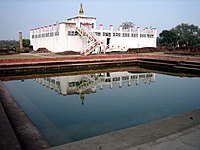Due to the arrival of disparate settler groups from outside through the ages, it is now a multi-ethnic, multi-cultural, multi-lingual country. . Central Nepal was split in three kingdoms from the 15th century until the 18th century, when it was unified under the Shah monarchy. The national language of Nepal is called 'Nepali', a name given - long after unification of Nepal - to the language called Khas Kura.
Nepal experienced a failed struggle for democracy in the 20th century. During the 1990s and until 2008, the country was in civil strife. A peace treaty was signed in 2008 and elections were held in the same year.
Many of the ills of Nepal have been blamed on the royal family of Nepal. In a historical vote for the election of the constituent assembly, Nepalis voted to oust the monarchy in Nepal. In June 2008, Nepalis ousted the royal household. Nepal was formally renamed the Federal Democratic Republic of Nepal when it became a federal republic.
Birth of Buddha
One of the early polities of South Asia was that of the Shakya clan, whose capital was Kapilvastu,Nepal. Siddhartha Gautama Buddha, Siddharta Gautama (563–483 BCE), who renounced his royalty to lead an ascetic life and came to be known as the Buddha ("the enlightened one") was born to the Shakya king Sudhodhana. After finding enlightenment, Lord Gautama Buddha returned to his home place Kapilavastu to teach his wife Yasodhara what he had learned. Buddha and his disciple Ananda are said to have visited the Kathmandu Valley and stayed for some time in Patan.
History of Nepal
Before Nepal's emergence as a nation in the latter half of the 18th century, the designation 'Nepal' was largely applied only to the Kathmandu Valley and its surroundings. Thus, up to the unification of the country, Nepal's recorded history is largely that of the Kathmandu Valley. References to Nepal in the Mahabharata epic, in Puranas and in Buddhist and Jaina scriptures establish the country's antiquity as an independent political and territorial entity. The oldest Vamshavali or chronicle, the Gopalarajavamsavali, was copied from older manuscripts during the late 14th century, is a fairly reliable basis for Nepal's ancient history. The Vamshavalis mention the rule of several dynasties the Gopalas, the Abhiras and the Kiratas—over a stretch of millennia. However, no historical evidence exists for the rule of these legendary dynasties. The documented history of Nepal begins with the Changu Narayan temple inscription of King Manadeva I (c. 464-505 AD) of the Lichavi dynasty.
Kingdom of Nepal
Main article: Kingdom of Nepal
Gorkha rule
After decades of rivalry between the medieval kingdoms, modern Nepal was created in the latter half of the 18th century, when Prithvi Narayan Shah, the ruler of the small principality ofGorkha, formed a unified country from a number of independent hill states. Prithvi Narayan Shah dedicated himself at an early age to the conquest of the Kathmandu Valley and the creation of a single state, which he achieved in 1768.
The country was frequently called the Gorkha Kingdom. It is a misconception that the Gurkhas took their name from the Gorkha region of Nepal; actually, the region was given its name after the Gurkhas had established their control of these areas. The Gurkha, also spelled Gorkha, are people from Nepal who take their name from the legendary 8th-century Hindu warrior-saint Guru Gorakhnath. Gurkhas claim descent from the Hindu Rajputs andBrahmins of Northern India, who entered modern Nepal from the west.
For more:
www.freshminute.blogspot.com
For more:
www.freshminute.blogspot.com



No comments:
Post a Comment